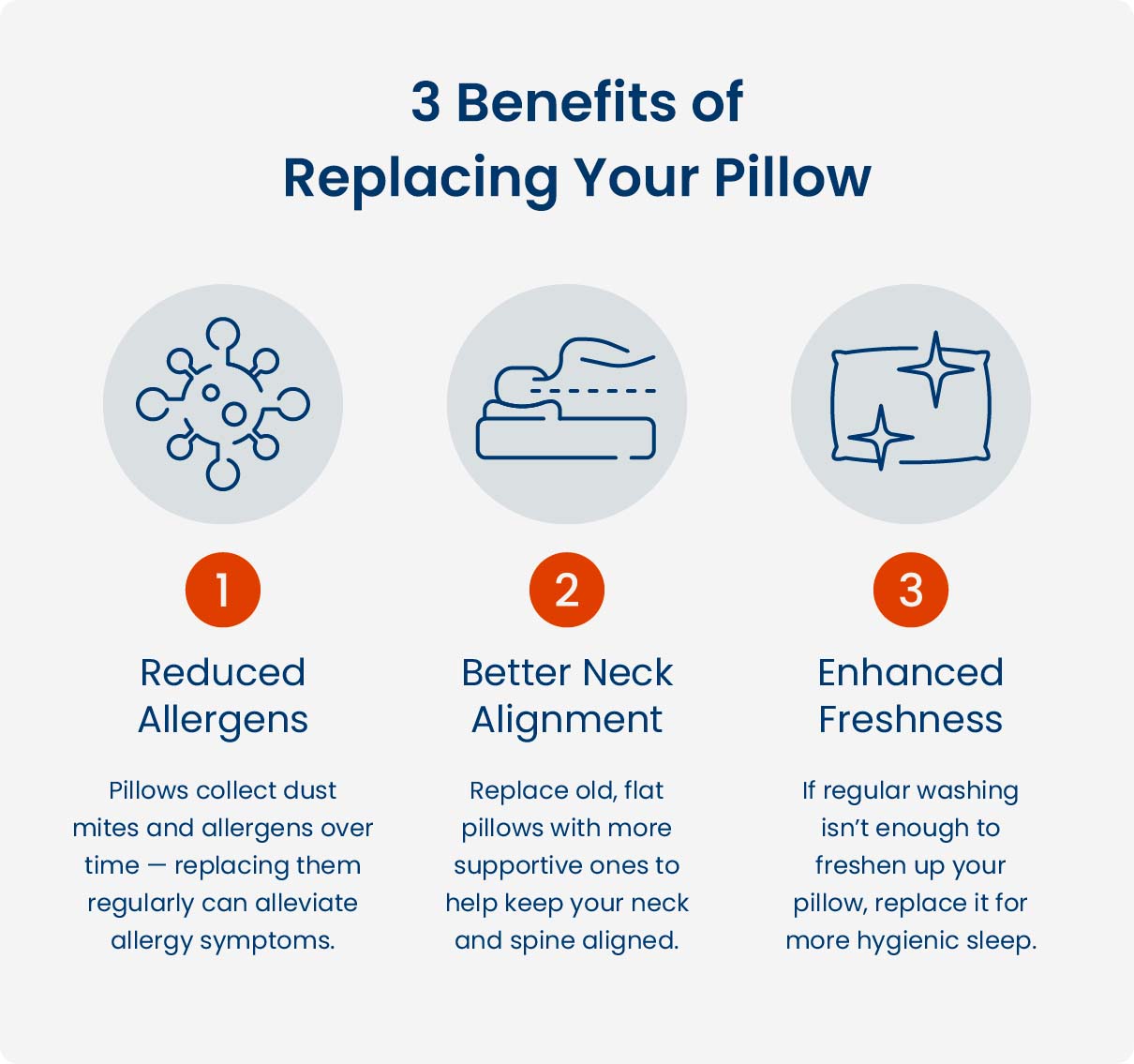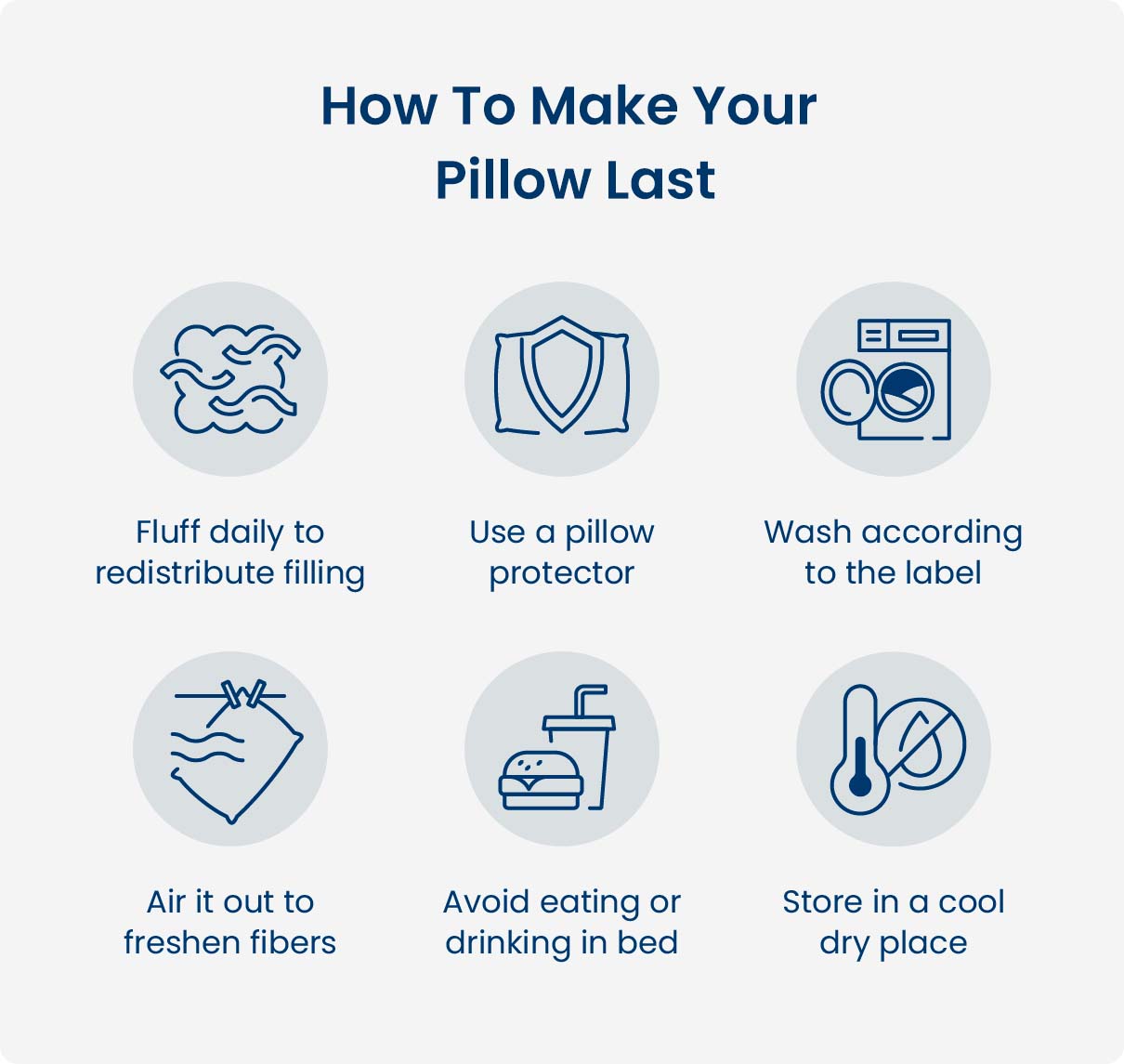We all know the feeling of sinking into a cool, fluffy pillow at night, but even the comfiest pillows eventually need to be replaced.
But how long do pillows last? It's a question many people don't consider until their once-supportive pillow leaves them with a crick in their neck. In this article, we'll explore the lifespan of pillows, decode the signs it's time for a replacement, and offer tips to maximize your pillow's comfort and longevity.
How Long Do Pillows Last?
The lifespan of a pillow depends on several factors, including the type of filling, care routine, and sleeping habits. Generally, pillows can last anywhere from one to three years. However, some high-quality pillows may last up to five years with proper care.
Here's why the filling matters: Down and feathers break down over time, losing their fluffiness and supportive qualities. Synthetic materials tend to clump or flatten, while latex is more resistant to wear and tear. Here’s a breakdown of how long each pillow material tends to last:
| Pillow Material | Average Lifespan |
|---|---|
| Down/Feather | 1-2 years |
| Polyester/ Down Alternative | 1-2 years |
| Memory Foam | 2-3 years |
| Polyfoam | 2-3 years |
| Latex | 3-5 years |
| Buckwheat | 10-20 years |
Down and Feather
Average lifespan: 1-2 years
Down and feather pillows are known for their luxurious comfort and coolness, but they tend to have a shorter lifespan than compared to synthetic options. On average, you can expect a down or feather pillow to last around one to two years with proper care. However, some high-quality down pillows can last up to five years with meticulous care.
The reason behind their shorter lifespan lies in the natural materials themselves. Down clusters and feathers break down over time, losing their fluffiness and ability to provide proper support. This may be accelerated by frequent use, heat, and moisture can accelerate this process. Night sweats, for example, can cause down and feathers to clump and lose their loft.
Polyester and Down Alternative
Average lifespan: 1-2 years
Polyester and down alternative pillows, often called fiberfill pillows, are popular choices for their affordability and hypoallergenic properties. However, they don't hold up quite as well as some other pillow materials.
Generally, you can expect a polyester or down alternative pillow to last around one to two years, with some higher-quality versions reaching three years.
Memory Foam
Average lifespan: 2-3 years
Memory foam pillows are known for their comfort and cradling support, but like any pillow, they don't last forever. You can generally expect a high-quality memory foam pillow to last around two to three years with proper care.
The key factor affecting a memory foam pillow's longevity is usage. The more you use it, the faster the foam compresses in areas where your head rests each night. This can lead to a loss of support and that luxurious cradling feeling. Factors like body heat and weight can also contribute to the breakdown of the foam over time.
Polyfoam
Average lifespan: 2-3 years
Polyfoam is a simpler, less dense type of polyurethane foam compared to memory foam. However, polyfoam pillows also tend to lose support after two to three years with proper care. High-quality polyfoam and those with supportive features can last up to five years.
Just like memory foam, polyfoam can break down over time due to use and exposure to heat and body weight. Regular fluffing and washing with cool water and gentle detergent can help extend the lifespan of your polyfoam pillow.
Latex
Average lifespan: 3-5 years
Latex pillows, known for their bounce and natural feel, outlast many other pillow types. With proper care, a latex pillow can provide comfortable support for three to five years, and high-quality versions can even reach seven years.
This impressive lifespan is due to latex’s inherent durability. Unlike down and feathers that break down or synthetic fibers that clump, latex is naturally resilient and retains its shape well.
If you’re looking for a new latex pillow, check out Eli & Elm’s cooling side sleeper pillow with adjustable latex and polyester filling.
Buckwheat
Average lifespan: 10-20 years
Ergonomically praised for their natural cooling and adaptability, buckwheat pillows can be incredibly long-term friends. With a little care, a buckwheat pillow will provide consistent support for an astonishing 10-20 years!
Similar to latex, buckwheat is far more resilient than clumping fillings or feathers. Buckwheat hulls are durable and hold their shape incredibly well.
Why You Should Replace Your Pillows

Pillows wear out over time, and they lose some of the comfort and support that you require to sleep peacefully. Here is why and how you should change your pillows and what advantages you will gain from a new one.
- Fewer allergens and better sleep quality: Pillows over time become reservoirs for dust mites, dead skin cells, and allergens.
New pillow replacements can greatly enhance your sleep quality and reduce allergy symptoms if you suffer from allergies. - Improved neck pain control: A flat pillow has lost its loft and supportive characteristics, causing your neck to flex at an unnatural angle during the night.
A new pillow that supports your head and neck in a proper position will keep your spine in alignment, minimizing pain and leading to improved sleeping position. - Increased hygiene and freshness: Pillows soak up sweat, drool, and other body fluids throughout time, providing a breeding ground for mold and bacteria. Washing may alleviate this to some extent, but used-up pillows have a tendency to harbor these impurities better.
Replacing pillows guarantees a fresher and cleaner sleeping condition, which should contribute to improved overall health.
Alongside these advantages, a new pillow can simply be cozier and more inviting, making sleep more comfortable.
Signs It’s Time To Replace Your Pillow
Even the best pillows have a shelf life. This helpful checklist will help you identify if it’s time for a new pillow.
- Loss of loft: Over time, pillows lose their softness and structure. If your pillow is flat and does not spring back easily when it is bent, it is time for a new pillow.
- Lumps and clumps: A lumpy pillow can disturb your sleep and may cause pain in your neck. If your pillow has lumps or some of the filling is more uneven, it is due for a new pillow.
- Stiffness or pain in the morning: If you wake up with a sore neck, stiff shoulders, or a headache, it might be a sign that your pillow no longer gives you the support you require.
- Allergy symptoms: Dust mites and allergens tend to live in old pillows. If you notice allergy or asthma symptoms during the night, a new pillow might remedy your discomfort.
- Difficulty falling asleep or staying asleep: An uncomfortable pillow can make it difficult to fall asleep, or even stay asleep during the night. If you're tossing and turning, the pillow may be the source of the problem.
- Noticeable yellowing or stains: Pillows may also develop discoloration or stains regardless of how often you launder them. If your pillow has discoloration or staining, it is probably time to replace it for sanitary purposes.
- You can feel the pillow structure: If you feel the structure of the pillow while the filling is in it, it indicates that the filling should be replaced.
- You had your pillow longer than three years: Most pillows should be replaced every one to three years, depending on filling type and care.
Tips To Make Your Pillow Last

Maintaining your pillow soft and supportive isn't solely a matter of changing it every few years. By taking care of it and doing maintenance regularly, you can lengthen its lifespan. Here are some simple steps to maintain your pillow and extend its lifespan.
Fluff for Continued Comfort
Just as you fluff your bed comforter to keep it in its loft, your pillow must receive the same TLC. Make it a point to fluff your pillow every morning when making the bed. This redistributes the filling inside the pillow so that it provides even support and does not clump together.
An evenly fluffed pillow holds its shape longer, resulting in a longer life span and an always comfortable night's sleep.
Protect Your Pillow With a Pillow Protector
A pillow protector provides a defense between your pillow and sweat, drool, dust, and all the other things that could find their way onto it. Not only does this keep your pillow cleaner and fresher longer, but it also minimizes the need to wash your pillow regularly, which can help lengthen its lifespan.
Select a breathable, hypoallergenic pillow protector that matches your pillow size exactly. Regularly wash your pillow protector together with your sheets and pillowcases, according to the care instructions for the protector material.
Wash for Lasting Freshness
Your pillow retains sweat, drool, and dust mites over time, leading to allergies and unpleasant odors. Washing it regularly is crucial in keeping your sleep area clean and hygienic.
Look at the care label on your pillow for special washing instructions since some materials will need a gentle touch. Otherwise, pillows can be washed every three to four months with cold water and a mild detergent. Do not use harsh chemicals or fabric softeners, which can compromise the filling over a period of time.
After you clean them, make sure to dry your pillows completely before replacing them on your bed. A wet pillow may promote the growth of mold and mildew, so select a location with some ventilation or put it in the dryer on low heat (check your care label first).
Give It Air To Breathe
Every couple of weeks, make time on a sunny, dry day (stay away from direct sunlight for latex pillows) to hang your pillows outside for a few hours to air out. This will reduce moisture, allow the fibers to freshen up, and naturally kill dust mites.
If the weather doesn't cooperate, airing out the pillows indoors near a window will also help for a few hours. Airing out strengthens your pillows' overall breathing ability and will help them stay fresh much longer.
Don’t Eat or Drink in Bed
Spills and crumbs are a formula for disaster to your pillows. Not only will they attract insects such as ants, but they can also discolor your pillow and become a breeding space for germs. Avoid taking meals in bed to foster a cleaner sleeping space.
Store Properly
When your pillows are not being used, provide them with a dry, cool spot to rest. Do not store them in wet basements or small closets. Use airy storage containers or just lay them flat on a shelf.
Storage keeps your pillows safe from dust, moisture, and even insects, keeping them fresh and ready for your next good night's sleep.
Feel Long-Lasting Comfort
There is a time for every pillow to be replaced. If you see evidence of wear and tear, wake up with pain and stiffness, or just haven't replaced your pillow in a while, it may be time to upgrade.
If you're in the market for a high-quality pillow that will stand the test of time, take a look at the pillows we have available here at Eli & Elm. Both our cooling side sleeper pillow and our pregnancy body pillow use high-quality sourced materials, so they remain comfortable and supportive for longer.













